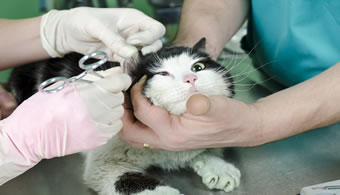
Steps for Treating a Wound
Cats are just as susceptible to everyday minor injuries as any other animal. Many cuts (lacerations), bruises (contusions), and scrapes (abrasions) are not life threatening and will heal with little treatment. Other wounds can be severe enough to require sutures and more intense emergency care.
What to Watch For
Fresh wounds will usually show some or all of the following:
- Bleeding
- Swelling
- Missing hair
- Cut, scraped or torn skin
- Limping
- Tenderness or pain
If a wound is not seen when it is fresh, it can become infected. In addition to swelling and tenderness, you may observe the following:
- Discharge (pus) from the wound
- Abscesses (i.e., an accumulation of pus under the skin) and the resulting hole in the skin when the abscess break open and drain
- Signs of a fever (e.g., lethargy and ears that feel hot to the touch)
Primary Cause
Wounds can come from bumping or hitting hard or sharp objects, avoiding cars, attacks from animals, and other dangers.
Immediate Care
What you can do at home is ultimately up to your cat. Sometimes the only thing you can do is wrap your cat in a towel or put him in a carrier and take him straight to your veterinarian. There are, however, a few things you can do if your cat will let you, especially if it may be a while before you can get to your veterinarian.
- If there is bleeding, apply direct pressure to the wound. The wound should be covered with sterile gauze or a clean cloth, and then pressure applied. It may take 5 to 10 minutes for bleeding to stop. Once it does, tape the gauze in place; removing it may remove the clot and bleeding will restart.
- Check for other wounds.
- If there is no bleeding and the cut (laceration) or scrape (abrasion) appears minor, try cleaning the wound. Use an antiseptic solution or plain water and gauze or a cloth (not cotton) to gently clean around the wound, and a syringe or similar device to flush the solution over the surface of the wound. Antiseptic solutions are made by diluting concentrated solutions bought at the store that contain either povidone iodine or chlorhexidine diacetate as the active ingredient. Do not use alcohol or hydrogen peroxide on the wounds, as these will actually damage the tissue. Povidone should be diluted to the color of weak tea; chlorhexidine should be diluted to pale blue.
- If the laceration is long or deep, or if it is a puncture wound, you can clean around the edges as already described, but do not flush the wound itself. Let the veterinarian do that.
- Once you have done all that you can, take your cat to your veterinarian.
Veterinary Care
Diagnosis
Your veterinarian will carefully examine your cat and evaluate all wounds that are found. Your cat will also be evaluated for indications of other problems. The cat’s hair will need to be shaved off for proper evaluation. Some wounds may require X-rays. Sedation may also be necessary to accomplish the examination.
Treatment

The basic goals of treatment are to prevent infection and speed healing. Different types of wounds require different methods of accomplishing these goals. Most of the time your cat will require sedation or anesthesia to treat the wounds safely and without causing more pain.
- Small scrapes and cuts often require nothing more than a thorough cleaning and maybe a little skin glue to hold the edges of the cut together.
- Long and/or deep cuts require careful cleaning to be sure there is no debris in the wound and careful examination to determine the extent of the damage. If the wound is less than 12 hours old and not heavily contaminated, it will probably be sutured closed.
- Puncture wounds, especially from animal bites, often have extensive damage under the skin that is not visible on initial exam. After removing any possible foreign materials, these wounds have to be thoroughly probed and then carefully cleaned with large volumes of antiseptic solution. Sometimes these wounds must be opened surgically to treat damage deep in the tissues.
- Meanwhile, puncture wounds and/or wounds that are over 12 hours old, contaminated or showing signs infection, abscessed, or missing large amounts of skin are usually not sutured. Instead they are covered with bandages until such time as the wound is healed or the wound is healthy enough that sutures will actually help the wound rather than trap infection inside.
- Large or deep wounds, contaminated wounds, or multiple puncture wounds often require the placement of a Penrose drain, which is soft rubber tubing that allows excess, contaminated tissue fluid to drain out, and keeps a small opening available for flushing antiseptic solution through the wound.
- Your veterinarian will give your cat medication for infection and possibly for pain, which you will need to continue giving at home.
- Most cats are released within 24 hours of being admitted.
Living and Management
The most important thing you can do once your cat is home is to provide good nursing care. Fortunately this is usually for only 1 to 2 weeks. Good nursing care includes:
- Keeping your cat from licking, chewing or scratching at the wounds, sutures, bandages, or drains. This may require the use of an Elizabethan collar.
- Keeping bandages clean and dry and changing the the bandages as directed by your veterinarian. This may be as often as 2 or 3 times a day initially. You may need to take your cat back to the vet for the changes, especially if he is not cooperative. If the bandages get wet, or you notice an odor, chafing, or an increase in drainage (or the drainage doesn’t subside), take your cat to the vet for evaluation.
- Placing a thin film of an antibiotic ointment around the edges of the wound once or twice a day, but only if the cat can’t lick it off.
- Making sure your cat gets all the medication that has been prescribed. If you are having trouble administering it, contact your veterinarian.
Unless the wounds are severe or complications develop, here is a typical schedule of events after the veterinary visit:
- Penrose drains are removed 3 to 5 days after being placed.
- Sutures are removed 10 to 14 days after being placed.
- Antibiotics are generally given for 7 to 10 days.
- Pain medication, if used, is usually given for 5 to 7 days.
- Bandages may be left on for as little as 24 hours or up to several weeks, depending on the nature of the wound. Bandage changes are at least once a day to start; longer intervals between changes may be possible later in the healing process.
If a wound, especially a puncture wound, was not seen, and if your cat did not take antibiotics, an abscess can form, resulting in symptoms described at the beginning of this article. Abscesses take about 10 to 14 days to develop, and often are not noticed until they rupture. An abscess will require another trip to your veterinarian.
Prevention
Since cats are most likely to be injured when roaming outside unattended, the best way to prevent injury is to either keep the cat inside or only let him out in a protected, confined area.
